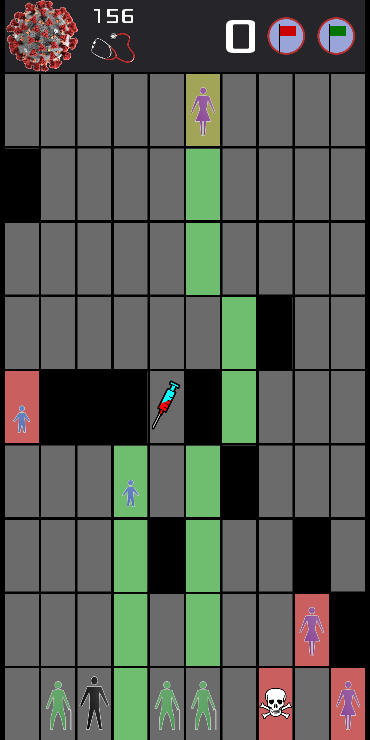
I created a limited clone of the 1980 Atari 2600 game Adventure, which introduced the Easter-Egg concept (as discussed in the movie/book "Ready Player One"). Like the original game, my clone has a hidden room. Can you find it?
I don't know if you ever had a moment to give Pandemic Puzzle a try, but I've made some significant upgrades in the last month. I added some game play improvements, some graphical polish, and fixed all known bugs.
I have updated Pandemic Puzzle, and I would appreciate getting some reactions to the game play. (Please read the instructions before playing.) The biggest problem now is that the game isn't fair in the sense that sometimes you just have to lose. You'll see what I mean if you play. I'm not sure of the best mitigation strategy at this point. Ideally, there would be multiple viable approaches.
Thanks for letting me know about OpenVR! I use Godot Engine, and Godot has an OpenVR add-on. That means I should be able to work with all the most popular hardware.
I looked into Quest a while ago. That is the platform which requires configuration with an Android app, which is made by Oculus, which is owned by Facebook. Installing anything made by a Facebook company is a non-starter for me.
I'm interested in VR hardware, but the Oculus and Valve offerings all seem to require that I create an online account and share personal information with the manufacturers--directly or by installing their Android app, which I consider spyware because it's not open-source. I just want to be able to treat the VR hardware like any other device connected to my computer without any 3rd party involved so I can test my own creations.
Does anybody know of any product I should check out? I'm aware of the headsets that basically just let you strap a phone to your head, but I'm not interested in that. I need to be able to interact with the hardware using Linux (Ubuntu).
This is still in rough shape, but I'm happy to have you take a look at it: https://kalbfled.itch.io/pandemic-puzzle.
Let's say you're into World of Warcraft. Every once in a while, you download an expansion pack--probably in the background because it's so large--to expand the world. What happens when the world is so large that it's too big to fit on your hard drive? Maybe you want to interact with the world from a mobile device, which has even more limited resources. One solution might be to stream the world to users as necessary--only transmit what the user can see now and in the immediate future. Services like Google Stadia somewhat reflect this premise, but they are streaming video, which will always require a lot of bandwidth. What if the stream were just geometry information, and the users' devices just run a game engine client?
I built out a proof of concept called Build the Oasis: City. You can download the client and receive the city geometry from a server while looking around for monkeys. (Shout out to the Blender community!) For a complete list of download options, including an unsigned MacOS version, or to contact the developer (me), visit https://www.buildtheoasis.com.
I'm particularly interested to hear from anybody who thinks this might be a useful approach to delivering their game's world. Regarding the video's emphasis on the reduction of overdraw, the response I typically get from professional game developers is, "Game engines already do that." My innovation, if anything, is the just-in-time deliver of geometry.
I've been developing a simple puzzle game inspired by the Covid-19 global crisis. The goal is to move people from one end of the board to the other without people becoming infected by the coronavirus. The threats aren't visible, so you have to infer their locations. The game is free for early access: https://kalbfled.itch.io/pandemic-puzzle.
At this point, the strategy is pretty simple. I'm hoping to receive some feedback that will help me make the game play more compelling.
